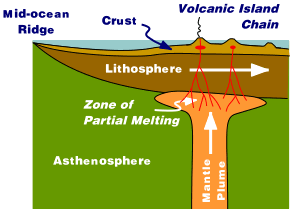|
Magma Generation and Volcanism
 | | Cross-sectional view of plume interaction with the lithosphere. Figure source: http://www.geo.cornell.edu/geology/GalapagosWWW/GalapagosGeology.html |
As plumes near the surface, they begin to melt. The melting occurs as a result of decompression (the decrease in pressure experienced by the plume as it rises) rather than any heating. Melting probably begins at a depth of 150 km or so and continues until the plume is prevented from further rise by the overlying lithosphere. Lithosphere is the relatively cool and rigid outer layer of the Earth that extends to depths as great as 100 km beneath oceans and 200 km beneath continents. Lithosphere forms as the underlying asthenosphere, which, though solid, is hot enough to flow, cools. The lithosphere beneath the Galapagos is relatively young, and therefore thin, perhaps no more than 15 km or so thick. Thus the region of melting beneath the Galapagos probably extends from depths of 100 or 150 km to 15 km. The temperature at these depths is 1400° C and more. By the time the melts reach the surface, however, they have cooled to 1100-1200° C.
The plume does not melt completely. At a maximum, only about 20 percent of so of it melts. The melt, or magma, is initially present as microscopic channels wetting the surface between mineral grains. Because it is less dense than the surrounding rock, however, it quickly aggregates and and begins to rise to the surface. Rising into the lithosphere, it eventually becomes trapped in large pools, called magma chambers at depths between a few kilometers and ten kilometers beneath the surface. Occasionally, the magma in the chamber is able to force its way to the surface, producing a volcanic eruption. Successive eruptions over hundreds of thousands and years produce a volcano. Some of the magma crystallizes within the magma chamber, thickening the crust beneath the volcano.
|







